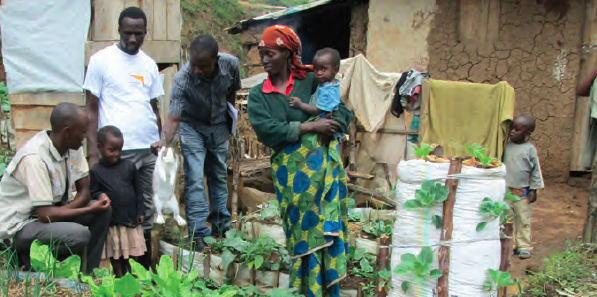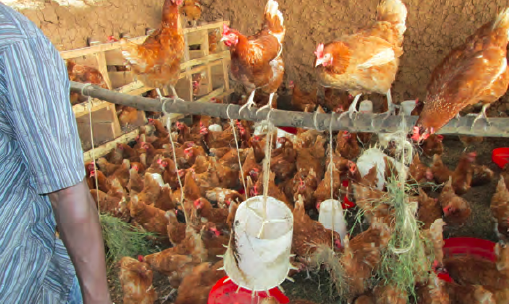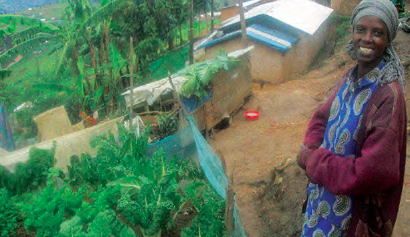A review of kitchen gardens, poultry farms and rabbit rearing aimed at diversifying the diets of Congolese refugees in Rwanda
 Esther Ogonda Mcoyoo, Angelot Gashumba, and Berhanu Demeke
Esther Ogonda Mcoyoo, Angelot Gashumba, and Berhanu Demeke
Esther is the Public Health Advisor with World Vision Rwanda.
Angelot Gashumba is the Humanitarian and Emergency Affairs Coordinator for World Vision Rwanda.
Berhanu Demeke is the Senior Programme Officer for Africa Humanitarian Action.
Background
The nutrition situation amongst Congolese people hosted in refugee camps in Rwanda is poor. A multi-agency nutrition survey conducted in Kigeme camp in 2012 reported the prevalence of global acute malnutrition (GAM) as 7.3% and severe acute malnutrition (SAM) as 1.5%. Stunting was reported as 38.6% and severe stunting at 15.1%. In response, Africa Humanitarian Action (AHA) partnered with World Vision Rwanda (WVR) and the UN High Commissioner for Refugees (UNHCR) in August 2012 to design and implement a multi-sectoral nutrition project with the aim of reducing undernutrition amongst the refugee children in Kigeme and Kiziba camps.
WVR, UNHCR, the UN World Food Programme (WFP) and AHA collaborated to implement several complimentary interventions to address undernutrition in the two camps including the provision of a general food ration, treatment of SAM and moderate acute malnutrition (MAM), health and nutrition education, and mother-to-mother support groups. Poultry and rabbit rearing as well as kitchen garden projects were designed to increase the dietary diversity of foods consumed by the families with children affected by SAM, MAM or with anemia (defined as hemoglobin less than 8-9.5 g/dl, or < 8 g/dl respectively as per the WHO classification).
In December 2014, at the end of the two and half year project, WVR conducted an internal qualitative evaluation. This article focuses on the results and learning from the kitchen gardens and poultry and rabbit rearing interventions.
Methods
A literature review, key informant interviews (with AHA staff, target recipients, community health workers, animators and other stakeholders in the camps) and focus group discussions (FGDs) with project recipients were conducted. A total of 13 interviews and 9 FGDs were held in Kigeme and Kiziba refugee camps.1
Overview of interventions
Kitchen gardens
Refugee families with children with MAM, SAM or severe anemia in Kigeme and Kiziba camps were supported to practice innovative ways of producing vegetables through the use of sacks/ basins and kitchen gardens to improve dietary diversity. About 154 and 377 kitchen gardens in Kigeme and Kiziba Camps respectively were established. AHA provided cabbage, carrots, spinach, onions, celery, peppers, eggplants and amaranth seeds to the identified families. A full time agronomist provided technical support, conducted demonstration gardening sessions and worked closely with project animators (whose main role was to educate and sensitize the refugee community on the importance and management of kitchen gardens, rabbit rearing and poultry farming, including disease management) and families in the project to continually support and monitor the gardens. Families that met the criteria for the project but whom did not have cultivation space were provided fresh vegetables on a weekly basis from the demonstration gardens whenever possible.
Poultry farming
Unlike kitchen gardens that were established at the household level, a poultry farm was developed with a local refugee association in Kigeme camp. AHA provided the technical expertise in constructing poultry pens and trained the animators and association members. AHA/WVI supplied the first set of chickens, veterinary services (including medication for the chicks), chicken feed for the first year, and security guard services for the pens.
The association was comprised of 15 families (each with a SAM or MAM child) who were willing to join and participate in the association. Membership of the poultry association was closed after the initial identification and registration of members. Families identified with SAM or MAM children subsequently were enrolled for the kitchen gardens or rabbit rearing which was easier to set up on an individual level. In December 2014, the association had about 169 improved egg-laying chickens which produce an average of 90 eggs per day. Every child in the project received 2 eggs per week to eat. On average, the association saved between 60,000 RWF to 70,000 RWF (USD 85- 100) per month, which was profit from the sale of eggs (80 RWF/0.1USD per egg). The association plans to increase their savings to 1,000,000 Million RWF (1,400 USD) and then start providing small loans to association members with a minimum interest rate, so as to promote entrepreneurship and support self-reliance among the association members.
“From 2 rabbits, my rabbits increase to 86 in 3 years. These helped me in diversifying my diets and giving my household a regular source income.”
Nyirabuhoro Janine; Kiziba refugee camp
Rabbit rearing
In Kiziba camp, rabbit rearing was established for families with a MAM or SAM child as well as chronically ill children (cancer, TB and HIV patients). AHA provided materials, supported families to construct rabbit hutches and trained families on rabbit rearing and health before they received a pair (1 male and 1 female) of rabbits. The agronomist and trained animators provided regular follow-ups visits. Rabbits were fed mainly on local shrubs and vegetables collected by families from the adjacent grasslands and forests. As a condition of participation in the project, each family gave back two rabbits to AHA that were then provided to other refugees to expand the intervention.
The three interventions were supported at a community level by a team of animators. Animators received both formal and on the job training on how to build and maintain kitchen gardens, rabbit and poultry hutches. There were 11 animators in each of the camps during the project. Each animator was responsible for 5- 6 villages where, on average, there were 7 to 10 households per village involved in kitchen gardens or poultry/rabbit rearing. Volunteers were used successfully in some areas to alleviate the workload of the animator.
Results
A total of 174 households were involved in one of the three interventions. Feedback from participants at the end of the project was positive. Participants reported that the kitchen gardens, poultry and rabbit rearing contributed to an increased diversity of food available and consumed at the household level. Participants interviewed also reported that they no longer sold part of their general food ration to meet basic non-food needs; instead they sold their extra produce, which provided them with a source of income. Some also shared their surplus produce with their neighbors.
Most of the refugees reported that they were happy to have farming activities to keep them physically and mentally active. Almost all (95%) households that had kitchen gardens, or were rearing rabbits or poultry are still maintaining them.
 Challenges
Challenges
There were many challenges faced by the kitchen gardens, poultry farm and rabbit rearing activities, including:
- Lack of materials such as plastic sheeting and sticks for protecting vegetable gardens and watering cans. Watering cans allow for controlled watering of young plants, without which the force of water can easily drown many plants. These materials were not planned and budgeted for; however, the refuges improvised using old mosquito nets to “fence” the kitchen gardens and some improvised watering cans by drilling holes in available containers.
- Stealing of rabbits and chickens in Kigeme and Kiziba camp was reported. This was discussed with the community and camp leaders and it was agreed that stolen animals were to be reimbursed by the identified perpetrators. Rabbits were kept at household level throughout the camps and individuals were responsible for guarding them. The employment of a full time night guard for the association’s chickens helped minimize theft. During the day, members had a roster for taking care of the chickens.
- Limited availability of land for farming activities. The densely populated refugee camps have limited available land for farming and often land is taken for community projects. In the future this could be addressed by using more sacks or basins to plant in which are more portable.
- Managing costs of chicken feeds for the poultry association. WVR provided the funding for feeds for the first year to take the project through start-up. However when funding stopped, the association had to use their income to purchase feed (approximately 10USD/day) though this still left a profit of 85-100 USD. The AHA agronomist is advocating with the government for feed (as they sometimes provide feed to such associations).
- Management issues. Two initial associations that were established for poultry and rabbit rearing in 2012 suffered internal management challenges that combined with high expectations of the members, led to their collapse.
- Limited number of animators and heavy use of volunteers. 11 animators were hired for the project with the idea that each animator could manage 7-10 households; however, animators felt this was too much. To support the animators, volunteers were identified in some of the villages. However there is significant turnover of volunteers as they often leave suddenly as they identify other sources of income.
“In addition to what I eat almost daily, every 2 weeks I sell my vegetables and get 10,000 RWF (14 USD) which I use to meet other household needs. Although there are no vegetables given in the general ration, I enjoy green vegetables in most of my meals.”
A refugee from Kigeme camp
Lessons learnt
It is important to consider the following:
- That the expectations of association members are managed well at the beginning of the project.
- The types and varieties of seeds and pesticides selected for kitchen gardens should take into account availability and viability of seeds produced from the resulting crop to reduce the number of distributions.
- How individuals can maintain the project (rabbits, poultry, gardens) once the external funding support ends. One suggestion for future kitchen garden projects is to form associations of individuals to whom trainings, support, and encouragement can be provided to establish a savings account to be used to run and maintain the costs of the gardens.
- How interventions can be integrated for maximum benefit, such as integrating kitchen gardening with rabbits rearing so that manure can be more accessible to the kitchen gardens.
- How cultural preferences of project participants can be taken into account. Refuges from certain religious backgrounds do not eat rabbits or chicken.
- On the job training is important and instrumental in knowledge sharing. Funding for formal (class-based) training for animators was limited however on-the-farm learning sessions were highly valued and effective in building knowledge and confidence.
- The need to identify a mechanism for accessing technical support throughout the project. Regular technical support visits should be encouraged as well as a mechanism for discussing technical issues such as a nutrition technical working group, in addition to the general monthly camp coordination meeting.
- Ensuring multi-sector collaboration and coordination is crucial. To implement the project, AHA engaged with the shelter, sanitation and water departments and services to understand construction plans and water cuts as these had impact on the project interventions.
 Conclusion
Conclusion
All recipients and implementing partners interviewed agreed that the activities were very relevant and allowed households to diversify their diets. Although the main funding for the programme has ended, AHA continues to provide limited support to families as they are still implementing other interventions in the camp. While quantitative results are still pending, the positive results from this qualitative study are being shared with partners and donors to advocate for integration of these activities into other refugee camps in Rwanda.
Footnotes
1 A key limitation to the internal evaluation is that it is based on qualitative results. UNHCR plans to conduct another nutrition survey in 2015.

